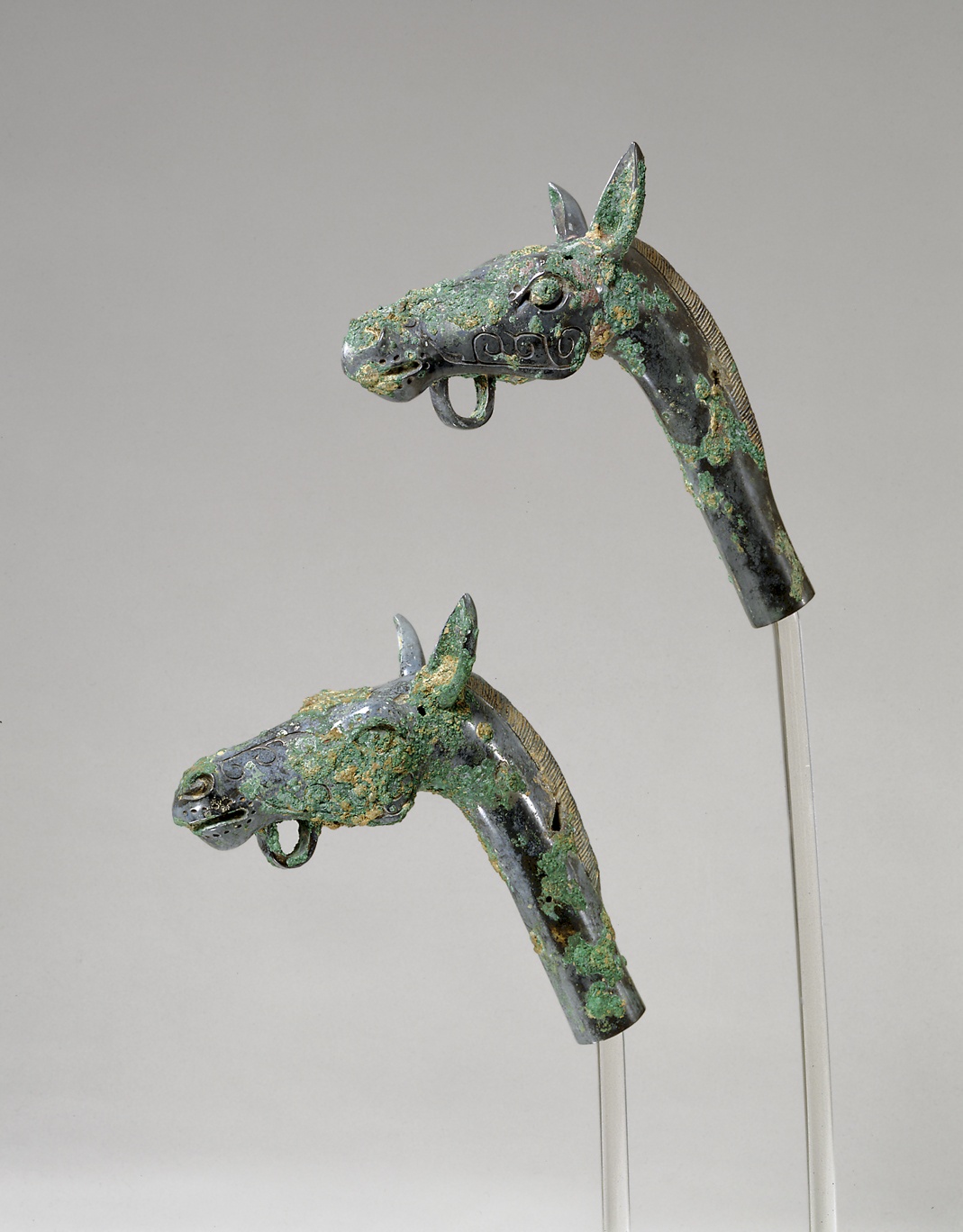
Bronze
H: a. 13.43 cm; b. 13.75 cm
Probably from a tomb in H'siao-t'un [1] (Northern Honan)
Early Chou
c. 1000 B.C.
Ex collection:
Dr. Otto Burchard, Beijing
George Eumorfopoulos
Mould-cast [2] with a core, worked in the cold and very thoroughly burnished and polished.
Condition: lustrous silvery grey patina with heavy red cuprite and rough green patches and ochre earth deposits. The present surface with the odd hole [3], a large one on the left side of both manes bears traces of soldering, probably remains of an ancient repair; on the upper middle of the neck of a., a pit also with similar traces. Holes around the mouth possibly for fixing hairs [4] and oval-shaped indents in front of each ear probably once inlaid.
Point of right ear of a. slightly chipped.
The horse heads and the other fittings surely adorned the same chariot [5] and were from the same workshop. Possibly from the same tomb whence reputedly came a celebrated bronze vessel of the kuei class [6] which W.P.Yetts thinks was in all probability manufactured in the nearby Wei capital. The finials, because of their high artistic quality, were surely also made there in an imperial workshop.
Since rumour had it that these four fittings came from the same tomb as the bronze vessel, it is interesting to note that W.P.Yetts, working on the vessel's inscriptions, suggests that it belonged to a ssu-t'u (one of the three highest administrative officials in a feudal state), a "'Minister of Instruction'; but probably his duties largely military". Thus the vessel would have been an offering in the family shrine to commemorate the ssu-t'u's contribution to the putting down of a revolt over the recently conquered Shang-Yin country. What could be more fitting for this Minister under the Marquis K'ang [7] who ruled over what became the Wei state than to have a magnificent chariot as part of his burial? The horse heads and the other fittings would have adorned it.
According to E. Bunker [8], a very similar bronze horse finial has been excavated on the Chinese mainland and dated 10th century B.C. For similar protomes of lesser quality there is a single example in the Paul Singer collection [9] and another in the Avery Brundage collection. The vibrant and highly naturalistic finials under discussion here, protomes of the small wild horse originally from the steppes of Central Asia, reveal an understanding that results from a close relationship with the animal.
The use of horse and horse-drawn chariots was associated with war and the ruling classes at the time.
On view: Fogg Art Museum, Cambridge, Massachusetts: 1940
Exhibited and Published:
Commemorative Catalogue of the Chinese Exhibition 1935 (London 1936), no. 148, p. 8 pl. 19.
Chinese Exhibition (Manchester, 1936).
Golden Gate International Exhibition (San Francisco, 1939), no. 19, pl. D.
The Animal in Chinese Art, cat. no. 211 (Neave-Hill, W.B.R.: Oriental Art XIV, no. 4, Winter 1968, pp. 324-325 fig. 7)
Animal Style Art, cat. no. 59, pp. 100, 88 ill.
Published:
Siren, O.: Kinas Konst Under Tre Artusenden I (Stockholm, 1942), p. 97 fig. 66.
Watson, W.: China before the Han Dynasty (London, 1961), p. 157 pl. 27.
Watson, W.: Early Civilization in China (London, 1966), fig. 47.
Keim, J.A.: L'Art animalier des Steppes, Jardin des Arts 194, Jan. 1971, pp. 14-20 ill., p. 21.
Mentioned :
Loehr, M.: Relics of Ancient China from the Collection of Dr. Paul Singer (New York, 1965), p. 154 (for cat. no. 43).
1 Next to river Huan near Hsü-Hsien or An-Yang Hsien.
Also exhibited here two other fittings (H: 10.08 cm, 10.43 cm) since from the same tomb and, the author believes, from the same chariot. They are similar in metallic appearance, surface and incrustation. On the George Eumorfopoulos oval collector's label the horse heads bore the numbers Br. 6 and Br. 7 followed by Br. 8 and Br. 9 for the two other fittings.
2 Cast using a multiple-piece mould, each ear in a separate section. This would be in keeping with the Chinese technique of the time when the great Shang and Chou vessels were made using multiple moulds all assembled together. The four finials exhibited were cast with the open end up, the molten metal remains being cut away and the tubes ground down.
3 Some casting faults, some to enable the insertion of pins to hold the core in place and the odd one later used for fixing the finials.
4 E. Bunker wrote us: "No way! Instead they are stylistic devices to suggest the texture of real hair." (23 August 1994.)
5 Watson, W.: China before the Han Dynasty, no. 27 pp. 255-256: "... probably came from a chariot burial."
6 Yetts, W.P.: An Early Chou Bronze, Burlington Magazine 70, 1937, pp. 168-177. After the author acquired these at a Sotheby's sale on 5 April 1960, he was told that W.P. Yetts considered that they came from the same tomb as this vessel, information supplied to him by Burchard, the collector and dealer in Beijing, after his article appeared. In it, Yetts states "The tombs are known to have been rifled before and between the occasions when scientific excavation was in progress, and to have yielded many bronzes."
7 Mentioned in the inscription p. 174 (see previous footnote).
8 Animal Style Art, no. 59, p. 100.
9 Loehr, M.: Relics of Ancient China from the Collection of Dr. Paul Singer, no. 43, p. 154. For a mention of the Avery Brundage example see E. Bunker: op. cit. (footnote 8).